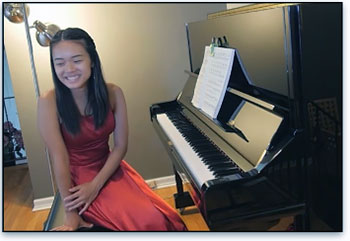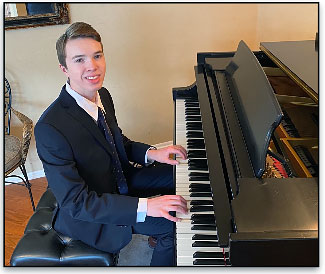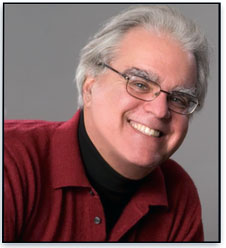Music Educators Association of New Jersey
Serving teachers and students since 1927


 Rebecca Hsiao, student of Florence Liu, dazzled the Zoom audience with her virtuosic performance of the first movement of Beethoven’s Appassionata, Sonata No. 23, Opus 57. Does Beethoven’s Allegro assai mean extremely fast? Our illustrious Juilliard Master Teacher Joseph Kalichstein stated that the Italian assai (meaning quite or very) was a nonequivalent translation of the German etwas (somewhat), Beethoven’s intention. This gave the movement a whole new meaning. Playing somewhat fast, the pianist must hold the listener’s interest from beginning to end and not run away with it.
Rebecca Hsiao, student of Florence Liu, dazzled the Zoom audience with her virtuosic performance of the first movement of Beethoven’s Appassionata, Sonata No. 23, Opus 57. Does Beethoven’s Allegro assai mean extremely fast? Our illustrious Juilliard Master Teacher Joseph Kalichstein stated that the Italian assai (meaning quite or very) was a nonequivalent translation of the German etwas (somewhat), Beethoven’s intention. This gave the movement a whole new meaning. Playing somewhat fast, the pianist must hold the listener’s interest from beginning to end and not run away with it.
The first page is an emotional roller-coaster with dynamic changes from pp to ff. The opening three notes of the broken F minor chord (pp) set the tone and should be legato—feel almost “sticky like walking in the mud.” The tension one must feel is not physical, but emotional—an inner feeling that must be present throughout the piece. Feel the expectancy of the recapitulation and the inner pulse. The music crescendos to arpeggios, which beg for pedaling not indicated in the score. The three notes whisper back in and crash into thick double forte F minor chords. To play these, Mr. Kalichstein suggests you mentally prepare so you don’t “grab” the last high chord. Make sure your wrist is relaxed and move faster sideways to the last chord — get there sooner than when you actually play it. This action requires arm and especially shoulder weight and motion.
 Mr. Kalichstein emphasized that overall the piece cries for more pedaling than what is indicated. Beethoven’s sonatas were longer, more virtuosic and orchestral than earlier sonatas and he was always seeking to get as much as possible out of the instrument. (See the February Highlights in which Dr. Aaron Wunsch discusses Beethoven’s sonatas.) In this sonata [written 1804-06], sonority equates to emotion so that the singing legato phrases are essential. Ferruccio Busoni of Bach-Busoni fame wrote a “love poem” for the damper pedal. He said it not only enhances the harmony, but also creates truly richer sound.
Mr. Kalichstein emphasized that overall the piece cries for more pedaling than what is indicated. Beethoven’s sonatas were longer, more virtuosic and orchestral than earlier sonatas and he was always seeking to get as much as possible out of the instrument. (See the February Highlights in which Dr. Aaron Wunsch discusses Beethoven’s sonatas.) In this sonata [written 1804-06], sonority equates to emotion so that the singing legato phrases are essential. Ferruccio Busoni of Bach-Busoni fame wrote a “love poem” for the damper pedal. He said it not only enhances the harmony, but also creates truly richer sound.
On the second page where the 'B theme' begins in A flat, enjoy the 16th notes and trust your ear. Playing the RH octaves takes skill. Mr. Kalichstein had Rebecca experiment by playing first with only the thumb, then only the 5th finger (upper octave). The thumb should become a secondary consideration; since the pinky is always weaker, the performer must make the thumb almost nonexistent. This helps to bring out the singing nature of this theme. As beginning students, we sometimes tighten up on octaves; as we mature, we must undo that memory. Try to rest the wrist on the long notes and engage the shoulder-elbow-wrist connection; keep it loose. At the end of the B theme, the trills should be calming, not too brilliant. Here again add pedal to soften the excitement. And maintain the tempo of the descending triplets that follow so as not to rush into the next section, which is dark, angry and loud. Hold the quiet A flat at the end of that section with the pedal or your fingers to prepare for the surprise key change that follows.
 Controversy may continue over the ensuing trills (on page 4), but Mr. Kalichstein recommends they be played from the upper note. Touch the pedal at the release so the sound doesn’t stop completely. Listen for it to linger (even where there are rests).
Controversy may continue over the ensuing trills (on page 4), but Mr. Kalichstein recommends they be played from the upper note. Touch the pedal at the release so the sound doesn’t stop completely. Listen for it to linger (even where there are rests).
The three chords in the Adagio measure just before the closing Più Allegro need pedaling as well. You want to create an “inner dread”; think with your ears to create rich sonority.
In the Più Allegro coda, notice the sf markings in the RH; make sure the LH doesn’t unintentionally add sf in response; try to give shape to these phrases. When the LH assumes the melody (six measures from the end) — and these last measures are impossible to play — try the LH under the RH rather than over. It’s much smoother that way. On the very last ppp F minor chord, let it totally die out to the barest whimper... while of course caressing the damper pedal.
 The next young artist in this Zoom Master Class was Conor Hampton, student of Sophia Ososkov. At tempo Prestissimo fantastico, Prokofiev’s Suggestion Diabolique, Opus 4, No. 4 was indeed fantástico in Conor’s capable hands. This was another technically challenging, dynamic performance. The tension and mystery Conor created in the beginning were sustained throughout, but Mr. Kalichstein cautioned Conor to maintain the tempo to hold on to the mystery — don’t give it away.
The next young artist in this Zoom Master Class was Conor Hampton, student of Sophia Ososkov. At tempo Prestissimo fantastico, Prokofiev’s Suggestion Diabolique, Opus 4, No. 4 was indeed fantástico in Conor’s capable hands. This was another technically challenging, dynamic performance. The tension and mystery Conor created in the beginning were sustained throughout, but Mr. Kalichstein cautioned Conor to maintain the tempo to hold on to the mystery — don’t give it away.
Because of the ridiculously fast pace, it is easy to lose some of the chromatic melody. Mr. Kalichstein suggested that Conor try to move even faster, get to [each] destination sooner — be above the note early and ready to play it. In order to achieve this, you must practice slowly. In measure 27, for example, the chromatic theme begins with eighth notes in the LH. You need to hear the first note of that theme, and again when it reappears in the following sequences on F sharp, on E flat, then with octaves in the RH. But you must be there to play that first note. Joseph Kalichstein related that in 1969 he spent two weeks studying with Vladimir Ashkenazy. He played the C scale over and over so that his thumb could move underneath his hand to the F as fast as possible. Simple, yet challenging.
 On page 4 where the B diminished 7th arpeggios crescendo to fff, ending in a blasting C chord, add pedal on that last chord. Use this chord as a jumping point. Keep the music exciting but don’t rush. Hold back and "don’t let the horses run away!”
On page 4 where the B diminished 7th arpeggios crescendo to fff, ending in a blasting C chord, add pedal on that last chord. Use this chord as a jumping point. Keep the music exciting but don’t rush. Hold back and "don’t let the horses run away!”
The glorious glissandos near the end signal the climax of the piece. The hands are playing in contrary motion — make it broader here, not exactly slower. Breathe (quickly) and follow with the staccato chromatic theme in the LH. Although it is marked pp, play it so it can be heard, not necessarily as written, because it is important to be able to hear the opening note of that theme. Also, again, practice this section slowly so that you train your LH to reach the first note of the theme sooner.
In the last two lines, marked pp, say a quiet farewell. Let the music fade away and the cacophony die out...
Thank you to Joan Bujacich, MEA Auditions Chair, for organizing the Zoom auditions for this event and to the judges — Alan Wasserman and Joe Bilotti. Thank you also to Beverly Shea for her lovely introduction to Joseph Kalichstein, to Yudit Terry, our president, and to Richard Allaway, our ever-present technology expert.
 Joseph Kalichstein is a frequent conductor of master classes at MEA and at colleges, music festivals and conferences around the world. He has been a piano faculty member at The Juilliard School since1983 (where he studied with Edward Steuermann and Ilona Kabos), and has served as the Edwin S. and Nancy A. Marks Chair in Chamber Music Studies since 2003. He is a founding member of the Kalichstein-Laredo- Robinson Trio, a renowned piano trio that has performed together and enthralled audiences for over 40 years. He serves as the Chamber Music Advisor to the Kennedy Center and is the Artistic Director of the Center’s Fortas Chamber Music Concerts.
Joseph Kalichstein is a frequent conductor of master classes at MEA and at colleges, music festivals and conferences around the world. He has been a piano faculty member at The Juilliard School since1983 (where he studied with Edward Steuermann and Ilona Kabos), and has served as the Edwin S. and Nancy A. Marks Chair in Chamber Music Studies since 2003. He is a founding member of the Kalichstein-Laredo- Robinson Trio, a renowned piano trio that has performed together and enthralled audiences for over 40 years. He serves as the Chamber Music Advisor to the Kennedy Center and is the Artistic Director of the Center’s Fortas Chamber Music Concerts.
With his diverse piano repertoire, he has performed with many of the world’s greatest orchestras, collaborating with such celebrated conductors as Daniel Barenboim, Pierre Boulez, Christoph von Dohnányi, Zubin Mehta, André Previn, and others. A favorite of New York concertgoers, Mr. Kalichstein has appeared in recitals on Carnegie Hall’s “Keyboard Virtuosi” series. His latest CD releases include music of Schumann and Brahms (on Koch International) and of Brahms, Mendelssohn and Schubert (“The Romantic Piano” on Audiofon).
Charlene Step, Editor and Layout Design
Lisa Gonzalez, Photos